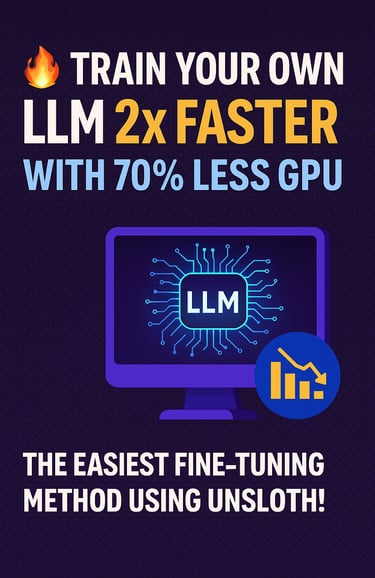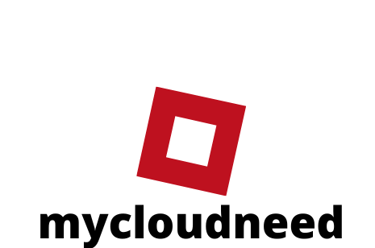Train Your Own LLM 2x Faster with 70% Less GPU – The Easiest Fine-Tuning Method Using Unsloth!
Discover how to fine-tune large language models (LLMs) effortlessly with Unsloth — the fastest and most memory-efficient method now. Learn how to reduce GPU usage by 70% and train twice as fast using this game-changing tool.
@AI
Ankit Kumar Tiwari
5/5/20255 min read
The world of artificial intelligence is witnessing a major breakthrough: the performance gap between powerful closed-source models like GPT and advanced open-source models has narrowed significantly. With innovations such as Meta's Llama 3.2 and other community-driven advancements, developers now have greater freedom to personalize and deploy large language models (LLMs) tailored to specific tasks. Fine-tuning these open models isn't just a theoretical concept anymore—it's becoming a practical necessity for those building specialized applications. From mimicking the unique tone of a brand to creating domain-specific tools in fields like law or medicine, fine-tuning allows you to hardwire critical knowledge and behavior into a model. Even better, recent tools and techniques now enable fine-tuning on consumer-grade GPUs, cutting memory usage by up to 70% and making AI personalization more accessible than ever.
Still, fine-tuning remains a complex process that goes far beyond just picking a model off Hugging Face. Success depends heavily on correctly preparing high-quality training data, selecting the right base model, and employing the best optimization strategies. A common alternative many developers use is Retrieval-Augmented Generation (RAG)—a method where external knowledge (like PDFs, websites, or proprietary databases) is turned into a vector store that a model can reference during inference. RAG is incredibly easy to implement and perfect for dynamic or real-time data, making it the go-to choice for most AI chatbot or knowledge base solutions. But it falls short when you need the model to deeply understand and replicate specialized workflows, like interpreting radiology images or responding in the quirky style of a celebrity. In such use cases, fine-tuning is the only viable path to truly embed this nuanced intelligence into the model.
For anyone serious about deploying custom AI models, knowing how to curate a proper dataset is the foundation. You can start with public repositories like Kaggle or Hugging Face, which offer curated datasets for sentiment analysis, ticket classification, and even medical image interpretation. Alternatively, if you have proprietary content—think customer interactions, transcripts, or training manuals—you can convert them into a structured format compatible with fine-tuning. Tools like AssemblyAI help transcribe audio/video recordings and even detect topics or sentiment, making it easier to prep data for training. But remember: structure matters. Each training entry should ideally contain a clear system prompt, user query, and AI response. Whether you're fine-tuning for legal advice, personalized education, or AI customer support, the path to a robust and affordable model starts with the right data pipeline, smart evaluation techniques, and thoughtful iteration. The AI revolution is here—and fine-tuning is your gateway to building AI that truly understands your world.


Synthetic data generation has emerged as a powerful breakthrough in AI model training, allowing developers to create vast amounts of high-quality training data without traditional data collection constraints. This revolutionary approach uses large language models (LLMs) to generate new datasets that can be used to fine-tune smaller, more efficient models for specialized tasks. The concept involves leveraging a powerful base model to produce a variety of outputs (such as answers to math problems), while a reward model ranks and filters these responses to select the best ones. This enables the creation of niche models that are both faster and cheaper to operate—ideal for real-world applications where performance and cost-efficiency matter.
One of the standout use cases involves enhancing creative prompts for image-generation tools like MidJourney. By pairing simple original prompts with highly detailed, improved versions, users can build fine-tuning datasets to train models for superior prompt engineering. This can be achieved by sourcing high-quality datasets from platforms like Hugging Face, which hosts collections such as “MidJourney Prompt High Quality.” Developers can extract refined prompts and use models like GPT-4 to generate basic versions, creating a paired dataset perfect for training. With the help of simple Python scripts and open-source tools, this entire process can be automated, drastically reducing development time and making AI training accessible to a wider audience.
Once the custom dataset is ready, the fine-tuning process begins. Whether you prefer open-source freedom or plug-and-play convenience, today’s landscape offers both. Platforms from companies like OpenAI and Anthropic allow easy upload of training files and take care of the fine-tuning and deployment. However, a key consideration is ownership—while these platforms offer convenience, they retain control over the model, limiting customization and portability. For developers and enterprises seeking full control over their LLMs, exploring open-source frameworks and hosting solutions remains the optimal route. As synthetic data generation continues to trend upward, it's reshaping how we build, refine, and scale intelligent applications across industries.
Today’s rapidly evolving AI landscape, choosing between open-source and closed-source models is more than just a technical decision—it’s a strategic one. While closed-source APIs provide convenience and scalability, they often come with high inference costs and vendor lock-in issues. Open-source models, on the other hand, offer freedom and control, but require substantial engineering effort to set up fine-tuning pipelines and deployment environments. Thankfully, hybrid solutions are emerging. Platforms like Together AI and Fireworks AI strike a balance by letting users fine-tune and deploy open-source models while offering flexibility to download and self-host later. If you're starting small but envision scaling up, these platforms offer a sweet spot—cost-effective, customizable, and scalable. Meanwhile, if full autonomy is your goal, there are deployment-focused solutions like Modal and RunPod that simplify the infrastructure layer for training and inference, enabling end-to-end control without needing a large team.
When selecting a base large language model (LLM) for your use case, it’s critical to weigh inference speed, cost, and specificity. While larger models promise higher accuracy, they’re slower and costlier—making them unsuitable for real-time applications like AI chatbots. Instead, small models (like 3B or 7B parameters) are proving increasingly capable and cost-efficient. For niche applications like converting user queries into SQL or automating code suggestions, fine-tuning specialized models beats using general-purpose giants. What's more, fine-tuning methods have evolved too. Instead of traditional full fine-tuning—which involves rewriting billions of parameters—techniques like LoRA (Low-Rank Adaptation) are revolutionizing the process. LoRA is like adding smart sticky notes to a book: minimal changes, maximum impact. This makes fine-tuning dramatically faster, lighter on GPU memory, and accessible even on consumer-grade hardware, helping solo developers and small teams scale without breaking the bank.
The fine-tuning revolution doesn’t stop there. Open-source tools like Unsloth are redefining what's possible with limited hardware. Imagine training a powerful LLM like LLaMA 3-7B on a free Google Colab T4 GPU in just 15 minutes—yes, it's real. Using quantization methods like 4-bit and 8-bit conversion, Unsloth shrinks model size without losing much performance, making AI training both faster and cheaper. It also supports automatic formatting of datasets using templates like ChatML, so you don’t have to struggle with pre-processing JSON manually. Combined with HuggingFace's training pipelines, Unsloth lets you train models that output nuanced, specific responses rather than generic fluff—perfect for creative tasks like enhancing MidJourney prompts or generating content-rich paragraphs. As the demand for low-latency, cost-efficient, and domain-specific AI solutions rises, learning to leverage tools like LoRA, Unsloth, and quantized LLMs can be a game-changer for developers, startups, and digital creators alike.
Start today and turn your creativity into cash :
mycloudneed is a cloud consulting and AI management company that helps businesses deploy, fine-tune, and scale custom large language models (LLMs) using AWS infrastructure. They specialize in hosting and training both open-source and proprietary models, offering secure API access, custom data training, and enterprise-grade monitoring. Their services are designed to be cost-effective, providing solutions that are up to 80% less expensive than traditional options like ChatGPT, while ensuring full control and customization for clients. By leveraging AWS services such as Lambda and API Gateway, mycloudneed enables businesses to own and manage their AI infrastructure efficiently.
